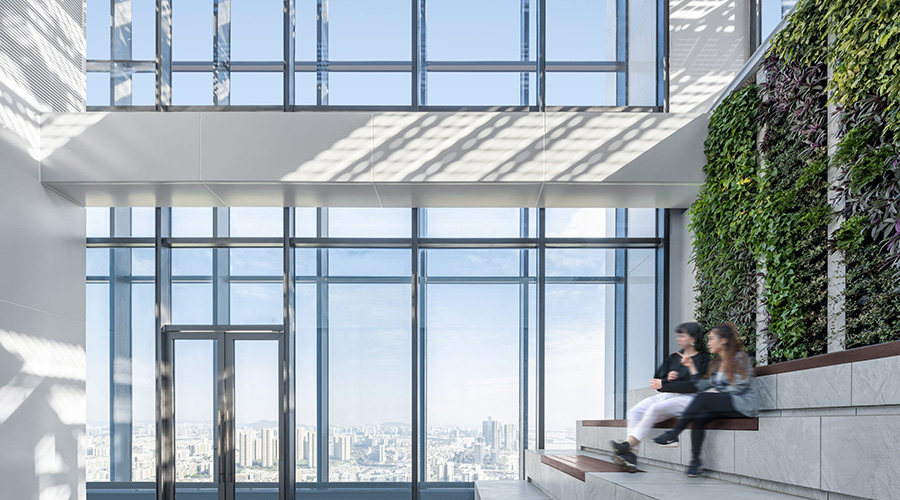Retrocommissioning: Calibrating HVAC Controls Saves Energy
Boyington’s retrocommissioning team included a design engineer, a consultant, general contractors, and maintenance and operations staff. The consultant recommended 18 measures the research facility could implement to reduce energy use and costs. The medical center incorporated 15 of those measures into the renovation project and is implementing the three remaining recommendations.
The most significant retrofit came in the form of a 30-ton, 12,000 cubic feet per minute air-handling unit installed on the rooftop above the institute’s administrative offices. The facility’s original design called for the central HVAC system to cool the laboratory spaces and the administrative offices. But because the laboratories require 100 percent outside air, the administrative offices were getting that same amount of fresh air — and consequently using too much energy — even though the air was unnecessary outside the lab environment.
Fortunately for Maine Medical Center, the team could add the rooftop unit fairly easily due to the building’s design. After adding the unit, all of the central air-handling capacity was dedicated to the laboratory side of the facility, which helped achieve the original design goals. Also, the unit above the administrative spaces, unlike the central system, can function in economizer mode. So despite installing a 30-ton air-handling unit, which typically would increase a facility’s energy use, the organization actually reduced its energy consumption, Boyington says.
While adding an air-handling unit was one of the most expensive renovations resulting from the retrocommissioning process, Boyington and his team also made significant progress toward energy efficiency with a handful of low-cost or no-cost retrofits.
For example, the first measure recommended by the consultant involved calibrating enthalpy controls for the central air-handling unit. This measure cost Maine Medical Center $1,200, but the consultant estimated it would save about $26,700 annually. This action has had the biggest payback among all the retrofits because the controls had a significant impact on improving the efficiency of the air-handling units. Ironically, a low-cost retrofit had produced the biggest results.
“It was a pleasant surprise,” Boyington says. “It definitely was not expected because nine times out of ten, you want to think that the thing that’s going to make the biggest difference is also going to cost the most. That would be the typical linear thinking.
“In the retrocommissioning world, we’ve found there are low-cost, no-cost bargains out there where certain things have been bypassed or certain things are in need of minor repairs or adjustments that allow the system to function the way it should have functioned in the beginning.”
Other measures incorporated into the project include:
• changing the operating schedule on air handlers, chillers, and boilers
• instituting a lighting survey, upgrading to high-efficiency, T8 fluorescent lamps, and specifying lighting controls
• relocating static-pressure sensors on four major exhaust fans
• isolating terminal heating equipment during non-heating season.
The retrocommissioning process began in spring 2004, and the medical center completed the retrofits associated with the project in spring 2005. Most of the renovations were related to the central plant, so despite the 24-7 nature of the laboratory, the team did not face scheduling challenges because the work took place outside of occupied areas.
“It was pretty smooth once we identified the opportunities and identified the remaining members of our team, whether it was the lighting consultant, the electrical folks or the mechanical folks that were going to help us,” Boyington says. “You identify the projects and get them on board.”
Since the completion of the project, the research institute has realized savings in energy use and costs: Energy use overall is down 10 percent. Here is a look at the annual savings related to natural gas, electricity and water:
• The research facility has cut down on natural-gas use by 2.5 million cubic feet, generating $28,600 in savings.
• The organization has reduced electricity by 250,000 kilowatts, saving $30,000.
• The building has reduced its water and sewer consumption by 1.1 million gallons, saving $7,000.
“The first thing was trying to establish a baseline (for the building), and the next thing was trying to establish the operating parameters of the systems within it,” Boyington says of the team’s approach to the project. “Then trying to make those as efficient and effective as they can be. That was the path that we used, knowing full well that it wasn’t going to be as energy efficient as some of the other buildings that we had to compare it to.”
Manager’s Role
Unlike the original design and construction process, Boyington and the operations and maintenance department spearheaded the retrocommissioning project.
“You have to be involved right from the very beginning, from the ground floor,” he says. “In the case of this building, there unfortunately was a lot of history that had gotten out ahead of us. We had a lot of catch-up to do as far as getting things going. Essentially, we took over an operating building.”
Boyington understood it was imperative his department get operating costs, energy use and environmental quality under control in a hurry. And despite the relatively young age of the building, Boyington did not waste any time getting the retrocommissioning project underway. During the project, Boyington remembered a quote he once heard related to retrocommissioning, which helped keep things in perspective throughout the process.
Says Boyington, paraphrasing the quote, “Every building gets commissioned eventually. Sometimes, those problems take 25-30 years to solve. Sometimes, it takes two weeks to solve them, but every building gets commissioned eventually. And this is one of those. As we started in the retrocommissioning process, we were finding opportunity after opportunity after opportunity of things to make better.”
Related Topics:













